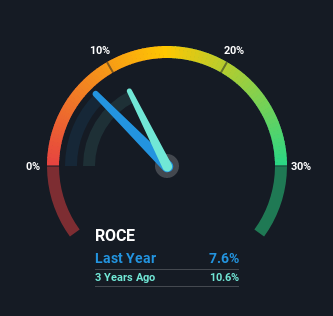- Hong Kong
- /
- Construction
- /
- SEHK:1722
Kin Pang Holdings (HKG:1722) Could Be Struggling To Allocate Capital

If we want to find a stock that could multiply over the long term, what are the underlying trends we should look for? One common approach is to try and find a company with returns on capital employed (ROCE) that are increasing, in conjunction with a growing amount of capital employed. Ultimately, this demonstrates that it's a business that is reinvesting profits at increasing rates of return. Having said that, from a first glance at Kin Pang Holdings (HKG:1722) we aren't jumping out of our chairs at how returns are trending, but let's have a deeper look.
Understanding Return On Capital Employed (ROCE)
Just to clarify if you're unsure, ROCE is a metric for evaluating how much pre-tax income (in percentage terms) a company earns on the capital invested in its business. Analysts use this formula to calculate it for Kin Pang Holdings:
Return on Capital Employed = Earnings Before Interest and Tax (EBIT) ÷ (Total Assets - Current Liabilities)
0.076 = MO$21m ÷ (MO$572m - MO$300m) (Based on the trailing twelve months to June 2021).
Therefore, Kin Pang Holdings has an ROCE of 7.6%. On its own, that's a low figure but it's around the 8.7% average generated by the Construction industry.
View our latest analysis for Kin Pang Holdings

While the past is not representative of the future, it can be helpful to know how a company has performed historically, which is why we have this chart above. If you'd like to look at how Kin Pang Holdings has performed in the past in other metrics, you can view this free graph of past earnings, revenue and cash flow.
What Can We Tell From Kin Pang Holdings' ROCE Trend?
In terms of Kin Pang Holdings' historical ROCE movements, the trend isn't fantastic. Around five years ago the returns on capital were 31%, but since then they've fallen to 7.6%. However, given capital employed and revenue have both increased it appears that the business is currently pursuing growth, at the consequence of short term returns. If these investments prove successful, this can bode very well for long term stock performance.
On a side note, Kin Pang Holdings' current liabilities are still rather high at 53% of total assets. This can bring about some risks because the company is basically operating with a rather large reliance on its suppliers or other sorts of short-term creditors. While it's not necessarily a bad thing, it can be beneficial if this ratio is lower.
The Key Takeaway
In summary, despite lower returns in the short term, we're encouraged to see that Kin Pang Holdings is reinvesting for growth and has higher sales as a result. But since the stock has dived 82% in the last three years, there could be other drivers that are influencing the business' outlook. Therefore, we'd suggest researching the stock further to uncover more about the business.
One final note, you should learn about the 4 warning signs we've spotted with Kin Pang Holdings (including 1 which is a bit concerning) .
For those who like to invest in solid companies, check out this free list of companies with solid balance sheets and high returns on equity.
Valuation is complex, but we're here to simplify it.
Discover if Kin Pang Holdings might be undervalued or overvalued with our detailed analysis, featuring fair value estimates, potential risks, dividends, insider trades, and its financial condition.
Access Free AnalysisHave feedback on this article? Concerned about the content? Get in touch with us directly. Alternatively, email editorial-team (at) simplywallst.com.
This article by Simply Wall St is general in nature. We provide commentary based on historical data and analyst forecasts only using an unbiased methodology and our articles are not intended to be financial advice. It does not constitute a recommendation to buy or sell any stock, and does not take account of your objectives, or your financial situation. We aim to bring you long-term focused analysis driven by fundamental data. Note that our analysis may not factor in the latest price-sensitive company announcements or qualitative material. Simply Wall St has no position in any stocks mentioned.
About SEHK:1722
Kin Pang Holdings
An investment holding company, provides building and ancillary services in Macau and Hong Kong.
Good value low.
Market Insights
Community Narratives



